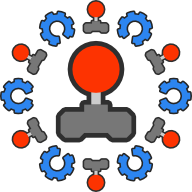From ZDoom: link to original post
We now have 1000 survey reports so I think it is time for a first summary.Here's the most interesting numbers, in parentheses the numbers from 4.7.0 with roughly 1300 users:
90% (85%) use Vulkan compatible hardware. This can be further divided into 65% on modern upper mid range to high end hardware and 25% low end to mid range.
4% (5.6%) use hardware which can run OpenGL with all features enabled but cannot run Vulkan. Note that this only considers theoretical support. Only 0.5% have hardware that is actually capable performance wise.
6% (9.1%) use legacy hardware which requires fallback solutions in the renderer and only has limited support for some features.
85% (75%) use a system with 4 CPU cores and more - among the Vulkan compatible systems this is 90% (82 %).
Currently Linux sits at 19%, macOS at 3.6%. The numbers were even higher before the download page was updated, so I expect them to shrink further. Over half of the reported Macs are ARM models already.
The numbers here are a bit weird in the low end segment. The lower mid range which includes all high end hardware of the last pre-Vulkan generation of hardware virtually imploded - the mentioned 0.5% is a mere 5 users reporting such hardware. 4 of these 5 users were early reporters so in the last two days only one single person reported such a system. Oddly enough the extreme low end has seen virtually no decline at all - the drop in OpenGL-only hardware almost exclusively came from the better hardware of this segment being on decline.
The same could also be witnessed at the lower end of Vulkan hardware. The vast majority of users these days uses a Geforce 960 or better (including AMD equivalents.)
So the trend that was already observable with 4.7 has continued with the user base getting ever more divided into two very distinct groups whose hardware has little to nothing in common.
User share of Windows 7/8 has dropped to 4.5% (18%), roughly 50/50 between owners of Vulkan compatible hardware and older setups.
I concluded the 4.7 survey with the following statement:
"Interestingly, the situation with CPU cores has not changed much at the low end. At the high end we are starting to see that many systems now come with 8 or even 16 cores, but the low end is virtually unchanged. So essentially we have the same situation as with graphics hardware - a large, fast moving group that frequently updates their systems and a slowly declining group of holdouts with old systems.
All this combined looks like there is a certain group of users which desperately holds on to their extremely outdated systems while everybody around them is updating their computers.
If this trend continues we may soon have a situation where the overwhelming majority of users has a system supporting modern render APIs but the remaining part of the user base cannot even use the OpenGL renderer with all features enabled. I am not sure yet how such a situation may play out - hopefully it gets mitigated by Windows 11 forcing a lot of users to upgrade and flood the second hand market with their Windows-11-incompatible systems, which then in return may drive out more of the truly ancient ones."
So here we are, one year later. I was actually hoping that Windows 11 and the drop in graphics hardware prices would bring some change - but apparently it did not. What we see instead is an increasing vacation of the middle ground while the size of the lowest end has only marginally declined over the last 3 years. This is actually becoming a serious problem by now because the need to support this segment is impeding the future development of the engine for modern hardware as most of our users own. We need two totally incompatible graphics APIs and two totally incompatible ways to use the APIs to serve both sides well - essentially meaning we need two different engines. Yes, there will be changes, we are currently evaluating our options.
Statistics: Posted by Graf Zahl — Wed Nov 09, 2022 2:22 am — Replies 3 — Views 143

You must be logged in to post a comment.